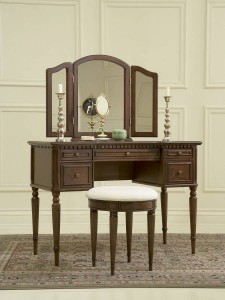
Traditionally seen on Roman architecture (and buildings modeled after that style) and other types of interior-decorating applications, dentil molding is no longer limited to buildings.
The word dentil is derived from the Latin dens, which means a tooth.
Classically speaking, dentils are a repeating architectural ornament in which small blocks are repeated. The earliest instance of dentil molding was in the tomb od Darius the Great, around 500 BCE.
The Romans use dentil molding as the primary decorative feature. In order to maintain consistency, a general rule was established that the projection of the dentil were to be equal to its width and the space in between would be half the width.
This ancient architectural element found its way into modern furniture, as with the Warm Cherry Vanity Mirror and Bench by Powell.
A number of timeless, traditional elements went into the design of this stylish set. The dentil molding on the underside of the edge accents five working drawers. These drawers rest on gently turned spindle legs with fluted and raised columns.
Constructed of hard woods and warm, rich cherry veneers, this mirror and bench convey formal time without being as stuffy.
We will continue to explore other types of molding as well as how they’ve made their way into our homes.
